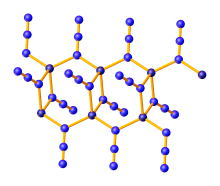Zinc azide
Zinc azide (Zn(N3)2) is an inorganic compound composed of zinc and azide. It is a white, explosive solid that can be prepared by the protonolysis of diethylzinc with hydrazoic acid:[1]
- Zn(C2H5)2 + 2 HN3 → Zn(N3)2 + 2 C2H6
 | |
| Names | |
|---|---|
| IUPAC name
Zinc(II) azide | |
| Other names
Zinc diazide | |
| Identifiers | |
3D model (JSmol) |
|
| ChemSpider | |
PubChem CID |
|
| |
| |
| Properties | |
| Zn(N3)2 | |
| Molar mass | 149.4 g/mol |
| Appearance | white solid |
| Density | 2.559 g/cm3 (alpha polymorph) |
Except where otherwise noted, data are given for materials in their standard state (at 25 °C [77 °F], 100 kPa). | |
| Infobox references | |
Properties
Zinc azide is a coordination polymer which crystallizes in three polymorphs, all of which feature tetrahedral zinc centers and bridging azide ligands. α-Zn(N3)2 crystallizes in the monoclinic space group and is stable, while the other two polymorphs are metastable. P21/n. β-Zn(N3)2 is trigonal, space group P3221, and γ-Zn(N3)2 is monoclinic, space group C2.
It is easily hydrolyzed, and attempts to prepare it in aqueous solution resulted in the precipitation of basic azides Zn(OH)2-x(N3)x (x = 0.9–1.0). Both the α- and β-forms were found to be very friction- and shock-sensitive, violently exploding in blue flashes, but can be made to decompose slowly by gentle heating, giving off nitrogen gas. In a sealed glass tube with inert atmosphere, this yields zinc nitride, Zn3N2.[1]
References
- Schulz, Axel; Villanger, Alexander (2016). "Binary Zinc Azides". Chemistry: A European Journal. 22: 2032–2038. doi:10.1002/chem.201504524.
| HN3 | He | ||||||||||||||||||
| LiN3 | Be(N3)2 | B(N3)3 | CH3N3, C(N3)4 |
N(N3)3,H2N—N3 | O | FN3 | Ne | ||||||||||||
| NaN3 | Mg(N3)2 | Al(N3)3 | Si(N3)4 | P | SO2(N3)2 | ClN3 | Ar | ||||||||||||
| KN3 | Ca(N3)2 | Sc(N3)3 | Ti(N3)4 | VO(N3)3 | Cr(N3)3, CrO2(N3)2 |
Mn(N3)2 | Fe(N3)2, Fe(N3)3 |
Co(N3)2, Co(N3)3 |
Ni(N3)2 | CuN3, Cu(N3)2 |
Zn(N3)2 | Ga(N3)3 | Ge | As | Se(N3)4 | BrN3 | Kr | ||
| RbN3 | Sr(N3)2 | Y | Zr(N3)4 | Nb | Mo | Tc | Ru(N3)63− | Rh(N3)63− | Pd(N3)2 | AgN3 | Cd(N3)2 | In | Sn | Sb | Te | IN3 | Xe(N3)2 | ||
| CsN3 | Ba(N3)2 | Hf | Ta | W | Re | Os | Ir(N3)63− | Pt(N3)62− | Au(N3)4− | Hg2(N3)2, Hg(N3)2 |
TlN3 | Pb(N3)2 | Bi(N3)3 |
Po | At | Rn | |||
| Fr | Ra(N3)2 | Rf | Db | Sg | Bh | Hs | Mt | Ds | Rg | Cn | Nh | Fl | Mc | Lv | Ts | Og | |||
| ↓ | |||||||||||||||||||
| La | Ce(N3)3, Ce(N3)4 |
Pr | Nd | Pm | Sm | Eu | Gd(N3)3 | Tb | Dy | Ho | Er | Tm | Yb | Lu | |||||
| Ac | Th | Pa | UO2(N3)2 | Np | Pu | Am | Cm | Bk | Cf | Es | Fm | Md | No | Lr | |||||